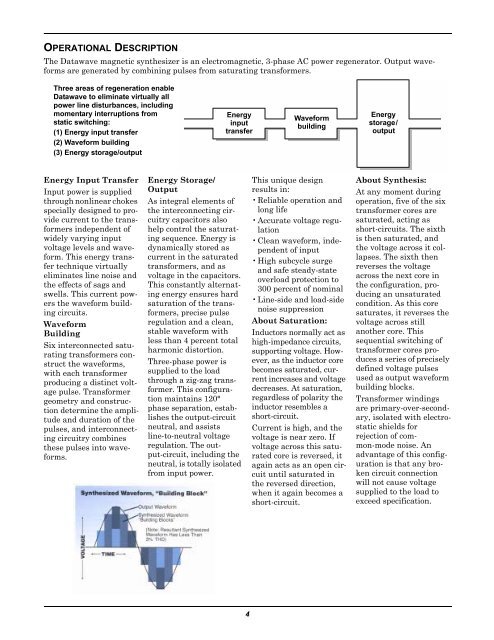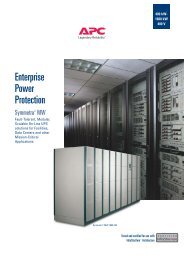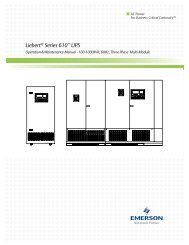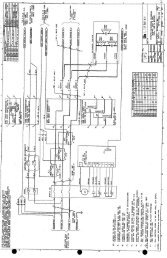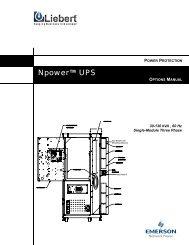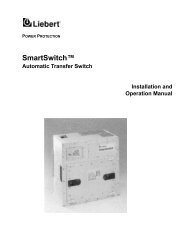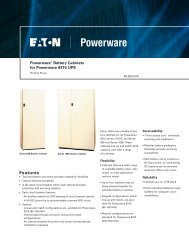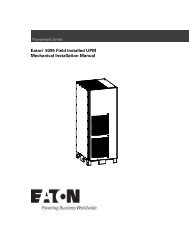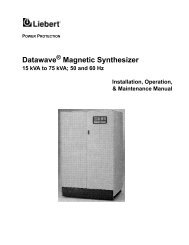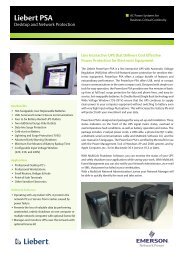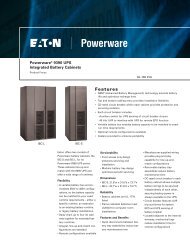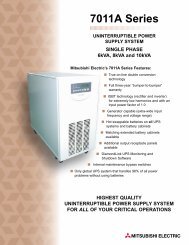Datawave - Emerson Network Power
Datawave - Emerson Network Power
Datawave - Emerson Network Power
Create successful ePaper yourself
Turn your PDF publications into a flip-book with our unique Google optimized e-Paper software.
OPERATIONAL DESCRIPTION<br />
The <strong>Datawave</strong> magnetic synthesizer is an electromagnetic, 3-phase AC power regenerator. Output waveforms<br />
are generated by combining pulses from saturating transformers.<br />
Three areas of regeneration enable<br />
<strong>Datawave</strong> to eliminate virtually all<br />
power line disturbances, including<br />
momentary interruptions from<br />
static switching:<br />
(1) Energy input transfer<br />
(2) Waveform building<br />
(3) Energy storage/output<br />
Energy<br />
input<br />
transfer<br />
Waveform<br />
building<br />
Energy<br />
storage/<br />
output<br />
Energy Input Transfer<br />
Input power is supplied<br />
through nonlinear chokes<br />
specially designed to provide<br />
current to the transformers<br />
independent of<br />
widely varying input<br />
voltage levels and waveform.<br />
This energy transfer<br />
technique virtually<br />
eliminates line noise and<br />
the effects of sags and<br />
swells. This current powers<br />
the waveform building<br />
circuits.<br />
Waveform<br />
Building<br />
Six interconnected saturating<br />
transformers construct<br />
the waveforms,<br />
with each transformer<br />
producing a distinct voltage<br />
pulse. Transformer<br />
geometry and construction<br />
determine the amplitude<br />
and duration of the<br />
pulses, and interconnecting<br />
circuitry combines<br />
these pulses into waveforms.<br />
Energy Storage/<br />
Output<br />
As integral elements of<br />
the interconnecting circuitry<br />
capacitors also<br />
help control the saturating<br />
sequence. Energy is<br />
dynamically stored as<br />
current in the saturated<br />
transformers, and as<br />
voltage in the capacitors.<br />
This constantly alternating<br />
energy ensures hard<br />
saturation of the transformers,<br />
precise pulse<br />
regulation and a clean,<br />
stable waveform with<br />
less than 4 percent total<br />
harmonic distortion.<br />
Three-phase power is<br />
supplied to the load<br />
through a zig-zag transformer.<br />
This configuration<br />
maintains 120°<br />
phase separation, establishes<br />
the output-circuit<br />
neutral, and assists<br />
line-to-neutral voltage<br />
regulation. The output-circuit,<br />
including the<br />
neutral, is totally isolated<br />
from input power.<br />
This unique design<br />
results in:<br />
•Reliable operation and<br />
long life<br />
•Accurate voltage regulation<br />
•Clean waveform, independent<br />
of input<br />
•High subcycle surge<br />
and safe steady-state<br />
overload protection to<br />
300 percent of nominal<br />
•Line-side and load-side<br />
noise suppression<br />
About Saturation:<br />
Inductors normally act as<br />
high-impedance circuits,<br />
supporting voltage. However,<br />
as the inductor core<br />
becomes saturated, current<br />
increases and voltage<br />
decreases. At saturation,<br />
regardless of polarity the<br />
inductor resembles a<br />
short-circuit.<br />
Current is high, and the<br />
voltage is near zero. If<br />
voltage across this saturated<br />
core is reversed, it<br />
again acts as an open circuit<br />
until saturated in<br />
the reversed direction,<br />
when it again becomes a<br />
short-circuit.<br />
About Synthesis:<br />
At any moment during<br />
operation, five of the six<br />
transformer cores are<br />
saturated, acting as<br />
short-circuits. The sixth<br />
is then saturated, and<br />
the voltage across it collapses.<br />
The sixth then<br />
reverses the voltage<br />
across the next core in<br />
the configuration, producing<br />
an unsaturated<br />
condition. As this core<br />
saturates, it reverses the<br />
voltage across still<br />
another core. This<br />
sequential switching of<br />
transformer cores produces<br />
a series of precisely<br />
defined voltage pulses<br />
used as output waveform<br />
building blocks.<br />
Transformer windings<br />
are primary-over-secondary,<br />
isolated with electrostatic<br />
shields for<br />
rejection of common-mode<br />
noise. An<br />
advantage of this configuration<br />
is that any broken<br />
circuit connection<br />
will not cause voltage<br />
supplied to the load to<br />
exceed specification.<br />
4


